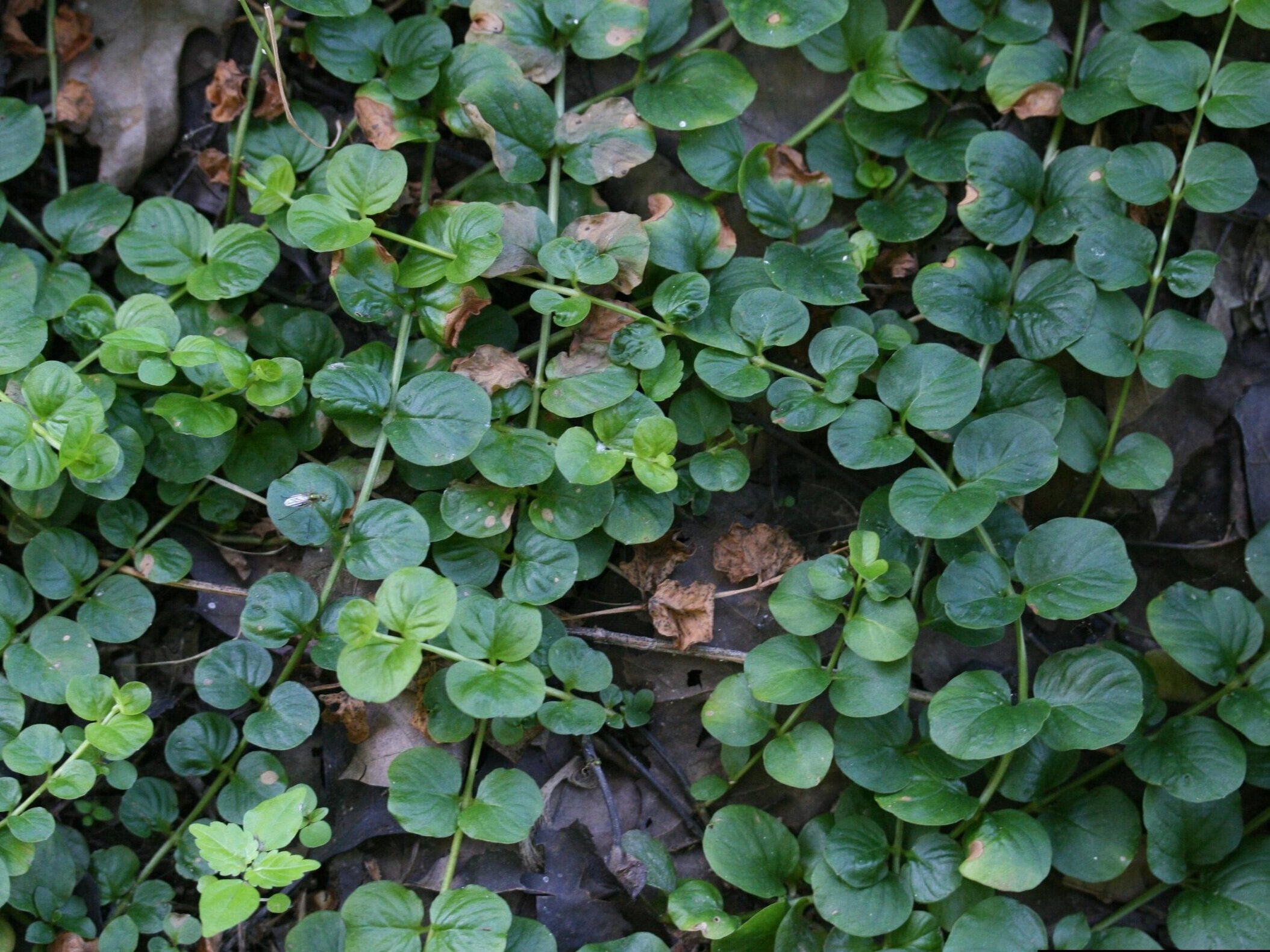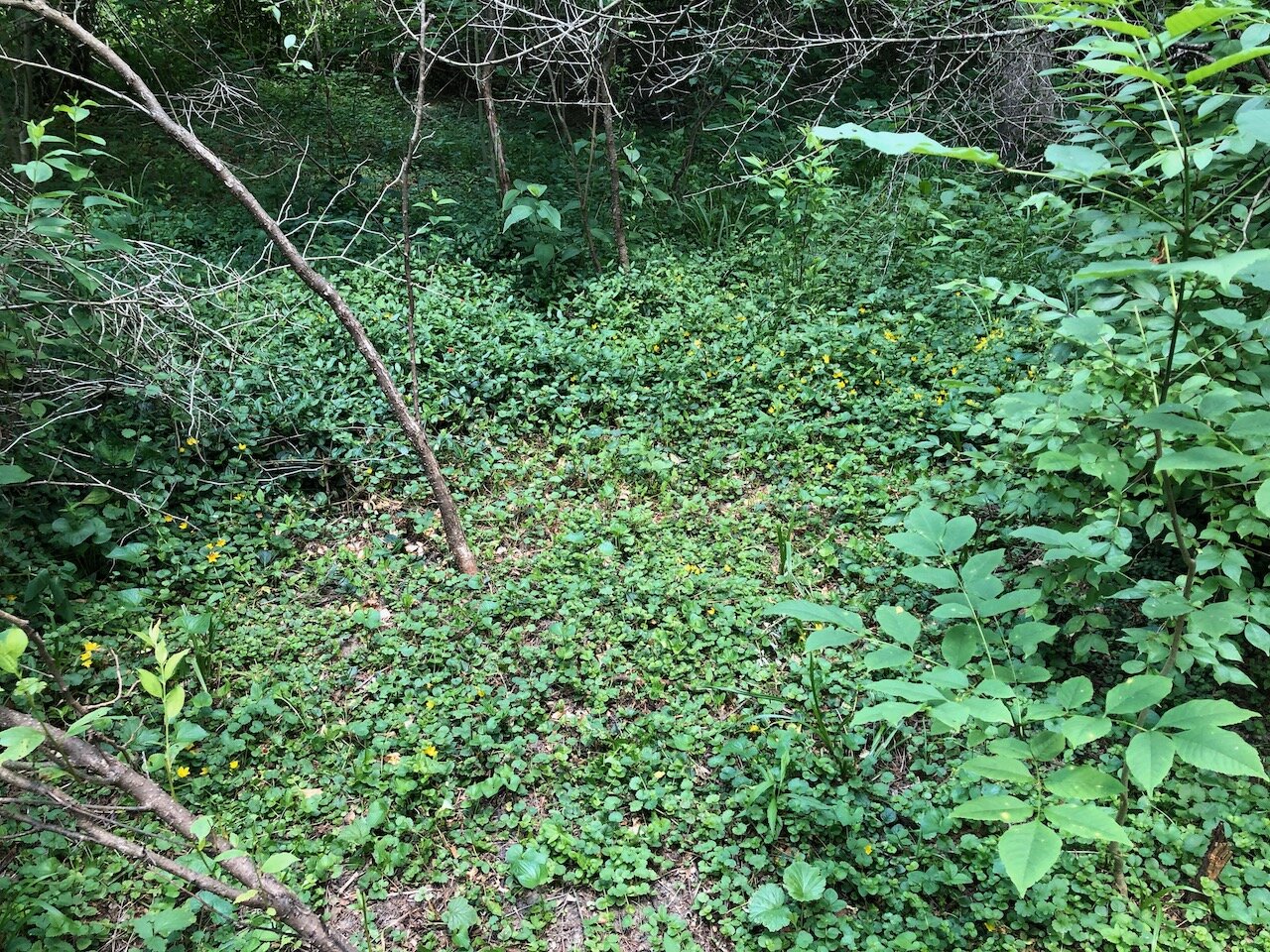July Invasive Plant of the Month
SICIM Email
Moneywort (Lysimachia nummularia)
Also known as creeping jenny and creeping yellow loosestrife, moneywort (Lysimachia nummularia) is a low-growing herbaceous invasive perennial which threatens wetland areas. Native to Europe and western Asia, this invasive plant was first introduced into the US as a horticultural groundcover in the early 1700s. Recently assessed as a high rank invasive in Indiana by the Invasive Plant Advisory Committee (IPAC), moneywort is still widely available in the nursery trade and is commonly sold as the cultivars ‘Aurea’, ‘Goldi’, or 'Goldilocks'. This species has been reported escaping into natural areas in all but one county in Indiana.
IDENTIFICATION & BIOLOGY: A member of the primrose family, moneywort is semi-evergreen, with prostrate branching growth habit, that roots at stem nodes, and forms dense mats. The common name moneywort is due to the appearance of the round, oppositely arranged, hairless leaves with smooth edges, that range from light-green to green-gold in color. The multi-branched stems are also light-green and hairless. Though blooms are infrequent, yellow 5 petaled flowers speckled with red dots arise from leaf axils in June-August. It may produce oval shaped seed capsules with 1-5 small seeds. Moneywort spreads primarily vegetatively, both by creeping growth as well as by rooting from stems and root fragments dispersed by water or through disturbance. It can also germinate from seed dispersed by water or soil movement.
LOOK-A-LIKES: Moneywort may be mistaken for a few other plant species, especially when not in flower. Our native partridgeberry (Mitchella repens) superficially resembles moneywort in that it has evergreen, opposite, rounded leaves and creeping habit. In comparison, partridgeberry is a slow growing, prostrate vine that has woody stems, shiny dark-green leaves with distinct light mid-veins, white trumpet-shaped flowers, and showy red fruits. Two non-native look-a-likes include the weedy common speedwell (Veronica officinalis) & the invasive ground ivy or creeping charlie (Glechoma hederacea) which are both creeping in habit with oppositely arranged leaves. To differentiate, common speedwell is a smaller plant with hairy stems, toothed leaves that are also hairy, and small light blue- lavender tubular flowers; whereas ground ivy has square stems, kidney shaped leaves with scalloped edges, and purple tubular flowers.
HABITAT & DISTRIBUTION: White moneywort is adaptable to a variety of growing conditions, it prefers rich, moist, shaded soils. It spreads aggressively in various wetland habitat including wet meadows, marsh, swamp, bottoms, forested floodplain, and along waterways and shorelines. It is also common in ditches and right-of-way areas. Moneywort is currently reported throughout most of eastern North America, along the west coast, and in a few US midwestern states west the Mississippi.
ECOLOGICAL THREAT: Due to its increasingly wide distribution and ability to form dense mats of vegetation in wetland areas, moneywort outcompetes our native plants, interrupts food webs, and reduces wildlife biodiversity. Its shade tolerance and evergreen characteristics give it an advantage over native species in many types of wetland habitat. There is some evidence that suggests moneywort may alter the hydrology of wetland areas where it is dominant.
CONTROL:
Prevention - The first priority to limit the spread of this wetland invader is to stop the use of moneywort in ornamental landscape plantings and remove it from any existing intentional plantings.
Manual - For small areas of moneywort or whenever practical, you can pull or dig out plant parts. However, any stem or root material left behind may give rise to continued growth. For larger areas or in wetland conditions, manual removal is discouraged since this soil disturbance can encourage spread. Mechanical mowing or string trimming is not recommended since moneywort grows below mower height and these practices is may result in further distribution of plant parts and soil disturbance.
Chemical - Herbicides such as glyphosate (non-selective) or triclopyr (broadleaf specific) may provide some degrees of control, but there is little documentation on chemical control success for moneywort. For chemical control in sensitive wetland areas it is essential to use herbicide products and adjuvants that are aquatic label.
IMPORTANT: The pesticide label is the law! When using any chemical control, always read the entire pesticide label carefully, follow all mixing and application instructions and use all personal protective gear and clothing specified. Contact the Office of Indiana State Chemist (OISC) for additional pesticide use requirements, restrictions or recommendations.
Fire & Cultural - For control in forested wetland areas, annual controlled burns in spring over the course of several years, when moneywort is actively growing and native vegetation is dormant, may suppress growth enough to allow native plants to regenerate. It may be useful to augment manual, chemical, and/or prescribed fire control with plantings of taller native plants such as grasses to shade out moneywort. Suggested native grasses include wood reed (Cinna arundinacea) and Virginia wild rye (Elymus virginicus).
Maintenance - Initial control efforts should be monitored regularly over the course of multiple years such that continued chemical and/or cultural control of persistent or new infestations may be required. For infestations along waterways, management downstream is recommended.
MONEYWORT HANDOUT: https://www.invasive.org/weedcd/pdfs/wow/monewart.pdf
MONEYWORT REFERENCES & OTHER RESOURCES:
https://www.eddmaps.org/species/subject.cfm?sub=5975#resources
https://www.fs.fed.us/database/feis/plants/forb/lysnum/all.html
https://www.illinoiswildflowers.info/weeds/plants/moneywort.htm
https://www.invasive.org/gist/products/handbook/methods-handbook.pdf
LOOK-A-LIKE REFERENCES:
https://www.minnesotawildflowers.info/flower/common-speedwell
https://www.illinoiswildflowers.info/woodland/plants/partr_berry.html
#moneywort #creepingjenny #lysimachianummularia #indianainvasiveplants #indianainvasviesinitiative #invasiveplantofthemonth



